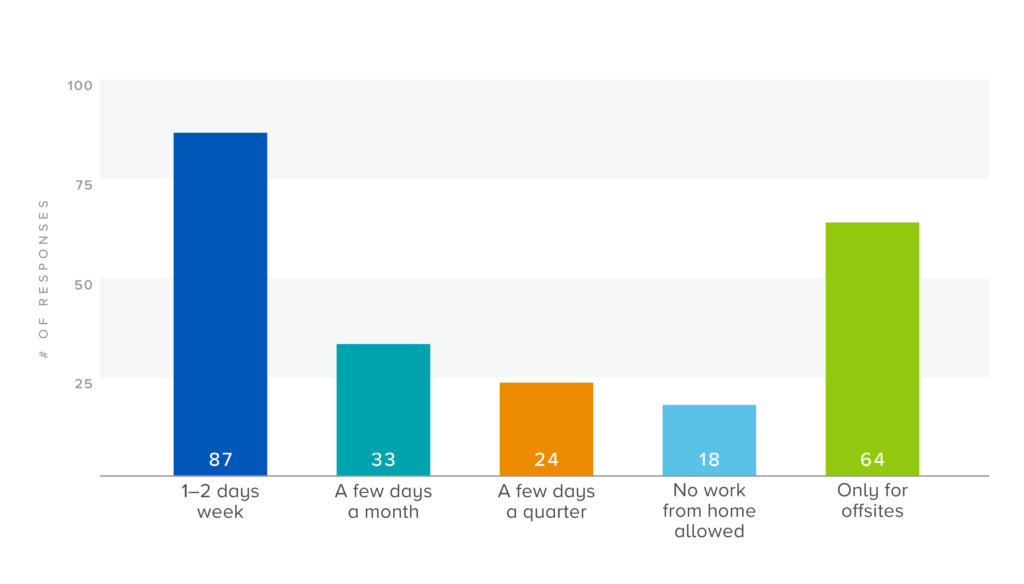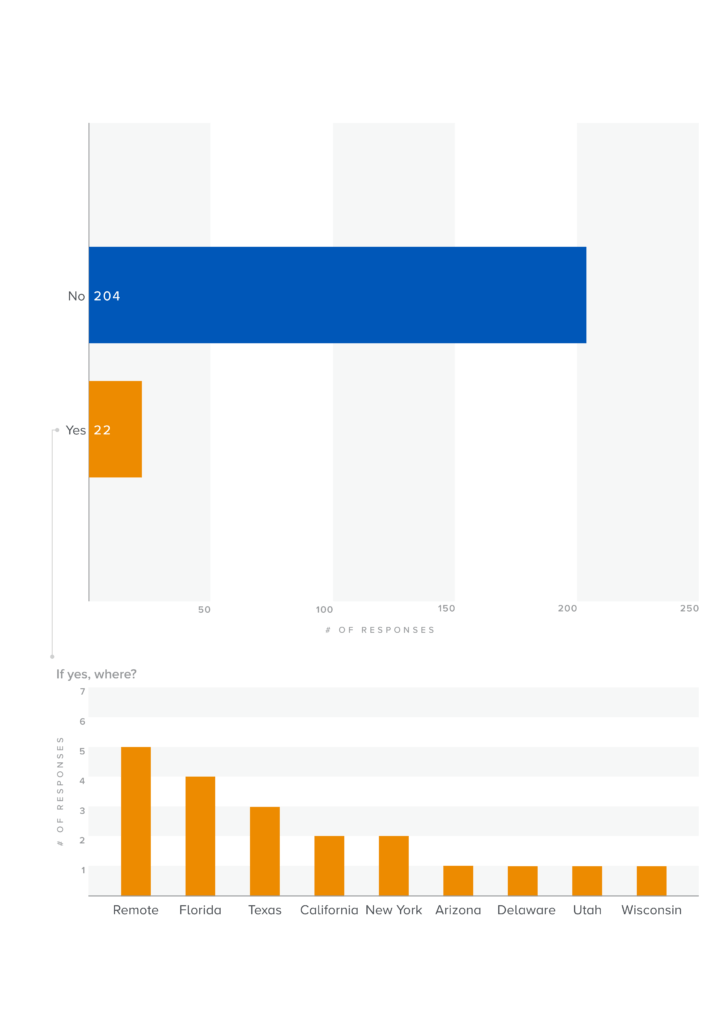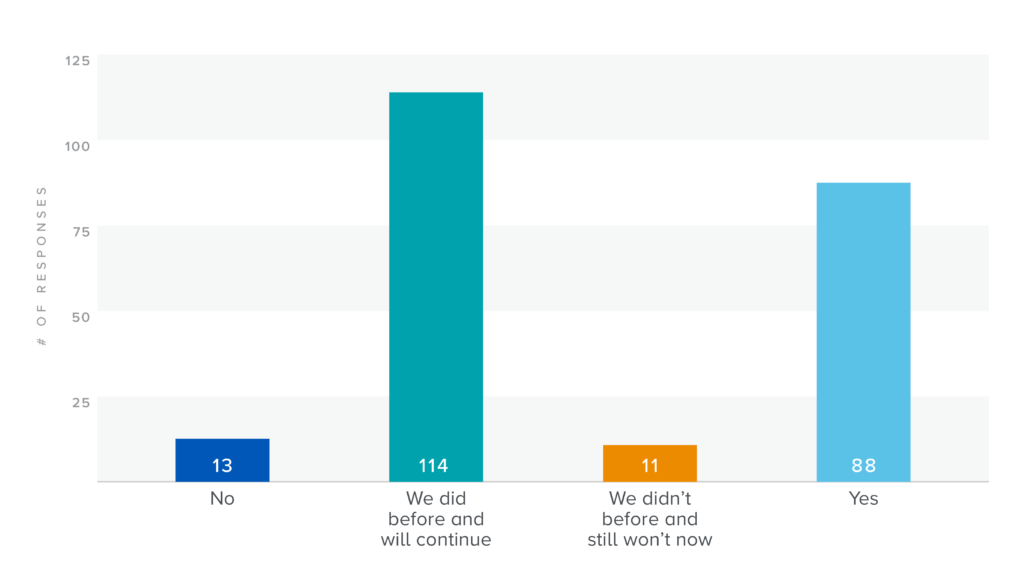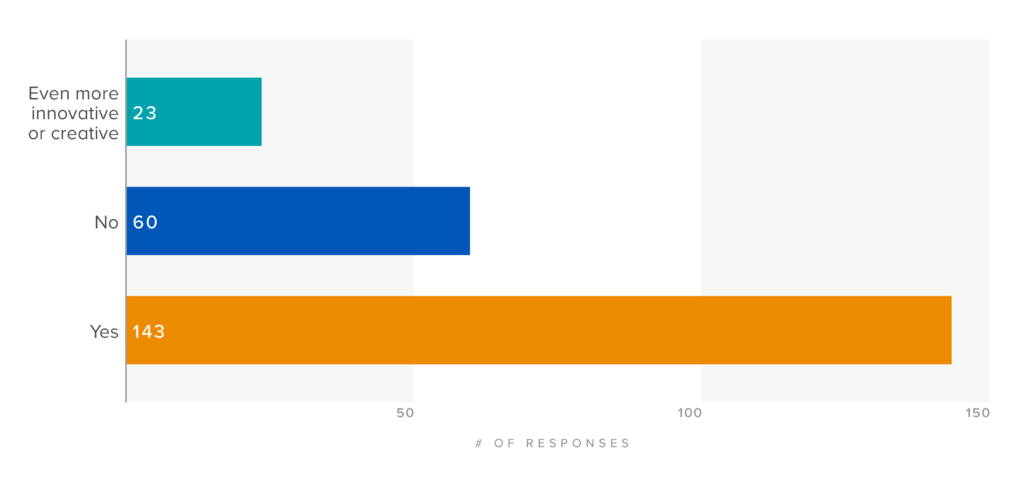Work during COVID has underscored how distributed teams working remotely can be effective and accelerated the shift from the way we worked in the industrial age to optimizing how we work for the information age. While the tech for working in remote and distributed teams was here before COVID, the pandemic was the impetus and accelerator for moving to a new way of working at scale.
However, while it’s clear that our work models changed in the past 18 months, it’s less clear what the long-term model (or models) for working will be — or what will be the most effective and competitive. We have heard plenty of speculation on the subject, but in reality, only 29% of workplaces were back to the office in May 2021, and we are still in the early stages of workplace experiments with hybrid and remote-first models.
At a16z, as at many other companies, we view the changes the pandemic brought about as an opportunity to rethink how we work and what’s best for our team today and in the future. As part of this exercise, we also surveyed 226 CEOs in our portfolio — representing early and late stage startups across bio, consumer, crypto, enterprise, and fintech — about their future location and remote work plans.
In this post, we highlight what we learned from that survey, including some of our favorite insights from founders (which we share as direct quotes so you can hear them in their own words), as well as how we are thinking about our own return to the office and remote work.
To see the full survey results, download the PDF here.
“The modern office building was invented to co-locate workers with paper documents in large filing cabinets. It was an anachronism well before COVID; the pandemic just accelerated people’s acceptance of the inevitable. I’ll bet even odds right now that the fraction of hours-worked that are worked remotely in 2023 will be 3x that of 2019.” -Kurt House, CEO at KoBold Metals
There are a lot of different ways to be remote-first or hybrid.
In our survey, about ⅔ of organizations said they would work in a “hybrid model,” with the majority of those opting to be in the office 1-2 days per week (38.8%) or in person only for offsites (28.6%).
In our survey, many CEOs noted their hybrid operating models were more nuanced than the survey options captured. While much of the conversation around the future of work and workplaces centers on the idea of a “hybrid working model”, the reality is hybrid is less a definitive category and more a catch-all that includes a wide (and growing) variety of operating models.
“Marc wrote software is eating the world a decade ago, what happened to every company that didn’t embrace software? This is such a cultural shift that’s happening, and while not as technologically derived, remote eats the world in exactly the same manner. The same way ecommerce crushed department stores, remote will win because it’s more efficient, cost-effective, and appealing to workers.
We are now a knowledge-based economy. Companies are their talent. If you don’t have great talent, you don’t have a company. What people want isn’t necessarily to be remote, but to be arbiters of their own fate. Hybrid in that sense isn’t about how many days per week you require employees to be in an office, but how much flexibility they have in designing when, where, and how they work. If you aren’t as remote or more remote than your competitor, where will the most talented people go? In the next three years, I predict we will see the highest turnover in history of top tier talent.” -Chris Herd, Firstbase
For most founders, the question then isn’t “should I go hybrid?” — because to be competitive, especially for top talent, companies will likely have some element of remote work — but how best to do it.
The a16z model
At a16z, three key inputs went into our decision: 1) How do we get the talent? 2) How do we work best together? 3) How do we win deals and continue to give founders a first class experience? We decided the way we best accomplish these goals was to give operating teams flexibility to set their own policies for when employees are required to be in the office, but give all employees the option to use a hotel-style booking system to reserve space in one of our offices. To stay competitive on deals that require us to be in person, we set a firm-wide policy that any employee be able to get to the office with a day’s notice. And to ensure we maintain our culture and connection, we will use regular offsites to build in person connection.
Other common hybrid models
“We are remote-first for computational positions. Most people we’ve talked with have a preference to be remote-first, and it expands the pool of hire-able people. We’re definitely going to have lab work be in person but have gone back and forth about whether longer term it makes sense to have a few smaller “hubs” in different geographic areas, or one single large lab/office. I’m not yet sure where we will land on the administrative end (i.e. CEO/C-level positions) and whether that will be in person or remote.” -Founder, company still in stealth
Another common hybrid model allows a particular function, such as engineering (where competition for talent is fierce and the work is suited to distributed teams), to be remote, but requires the rest of the organization to be in person. One of the more creative approaches we have come across is Wise, which gives employees an annual amount of days to work anywhere, so people can go abroad for a season or focus on being home with kids during school holidays. And, of course, there are companies — Netflix, perhaps, the most well-known — where the product or culture mean in-person will prevail.
“We have a wet lab, so we really need to be working together in person to maintain creativity and velocity of the lab work in particular, and it’s also easier for non-experimentalists to work more closely with experimentalists if it’s in person.” -Sri Kosuri, CEO at Octant Bio
CEO/founder relocation is a leading indicator for how remote workplaces will be.
One of the main questions we hear is whether remote and hybrid work will remain the norm, or if over time, there will be a gravitational pull back to a central office. For that question, we think the leading indicator is what senior leaders are doing. If the CEO is working remotely, it’s more likely the organization will develop a true remote-first culture. On the other hand, if CEOs and leaders are in the office, there will naturally be a gravitational pull for more workers to be there, in-person.
In our survey, we found 16.8% of CEOs and 9.7% of organizations had plans to relocate from existing headquarters. Board meetings are also going hybrid/remote, with 54.4% of organizations planning hybrid environments for future board meetings, 32.3% prioritizing remote-first, and only 13.3% preferring going back to all in-person.
Where are companies moving?
While there is a lot of chatter about “new Silicon Valleys” emerging in Miami, Austin, and other locations, our survey didn’t find a singular trend, and instead CEOs listed a range of locations, when asked where they were relocating.
Inherent in the decision is personal bias
When it comes to deciding to go remote, go back to the office, or split the difference, any decision maker has an agency problem, because we all have a personal stake and preference for how we work. The exec who has two kids at home may be thrilled to get back to the office where they can focus, while another may find they have more quality time with their family now that they are not spending hours every week commuting. In either case, personal preference can skew the decision.
Intellectual honesty and separating personal preference from what is best for a company can be hard in these decisions, and many leaders conducted employee sentiment surveys, evaluated recent and historical business performance, and considered company readiness for remote work to provide more structure around the decision-making process.
“Our company was approximately 65% remote prior to the pandemic, so we already had a working model in place. Based on recent employee surveys, I suspect when we return to the office, we will remain ~80-85% remote. The feedback from our team has been clear, the professional and personal productivity benefits are outweighing the desire for daily in-office interactions.” -Yancey Spruill, CEO at DigitalOcean
Hiring and competing for talent are forcing companies to adopt more flexible and more remote work models
The best talent has the ability to decide how and where they want to work, and they have more options as more workplaces go hybrid. A Microsoft study at the start of 2021 found 41% of employees are considering leaving their current employer, and almost half (46%) of those are considering a move because they can work remotely. More recently, in June 2021, a Bloomberg survey found 39% of workers would consider quitting if there wasn’t an option for remote work and the number jumps to 49% for millennials and Gen Z.
In short, the competition for the best talent, especially the best technical talent, is fierce, and many workplaces who prefer in-person work are making exceptions to match the desired location and lifestyle of certain employees, most often the top technical talent (e.g. an L7 engineer). In our survey, we found almost 90% of organizations will continue or plan to hire remote employees.
“Over the last year we’ve had to hire many folks in remote locations, and cannot ask them to move in the near future. That set a precedent for a hybrid team.” -Travis Boatman, CEO at Carbonated
“While we believe innovation and productivity are best achieved from working together in-person, we want to hire and support the best talent — and in some cases that will require a hybrid model.” – Ariel Cohen, CEO at TripActions
While there has been a lot of discussion about whether remote teams can be as productive and creative as in-person teams, the discussion often overlooks that a remote team allows companies to uplevel their talent pool, so that what they lose in productivity they may gain (and then some) in talent. Additionally, giving employees the work environment and lifestyle that they desire can improve retention and loyalty in a hypercompetitive labor market.
“Do you think your company can be as innovative and creative in a remote or hybrid work environment? No, but it’s not an apples to apples comparison because the hiring pool and talent are different. Being in person is much better for innovation and problem solving, but the fact is, on average, we are attracting much higher quality talent now that we are remote. The up leveling in the talent pool may allow us to be more innovative going forward.” -Brew Johnson, CEO at PeerStreet
“Don’t underestimate the loyalty that will come with flexibility for these really in-demand technical roles. In Silicon Valley, top engineers go where they’ll get the best comp and ability to level up. But when your job gives them the lifestyle that they love, you have a different relationship and type of talent than the Silicon Valley engineer equity hopping through their mid-30s.” -Meltem Kuran, Head of Growth at Deel
We are only at the very beginning of this shift to a new way of working that redesigns workspaces for the opportunities, challenges, and tools of the information age. We expect we will see a lot more experimentation and iteration, especially at startups and tech companies driven by knowledge work.
In the near term, hybrid and remote work comes with more flexibility and more complexity, raising a second order of questions: How do you keep workers from burning out when the line between work and home is no longer physical, but digital? How do you communicate and collaborate with employees in different time zones? How does compensation and compliance change when employees are in different countries, not to mention different states? We’ll look at these questions and more in a future post on the operational complexity of remote work.
-

a16z editorial







